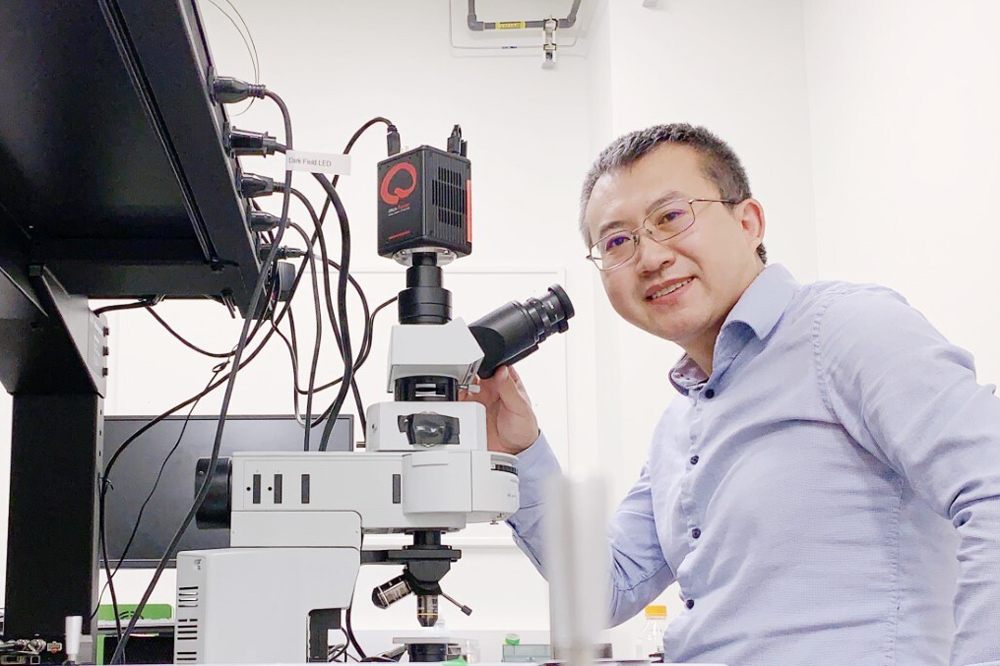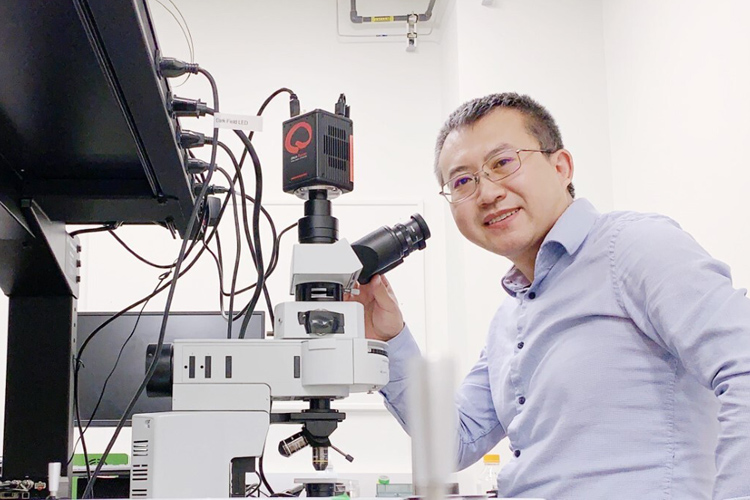
University of Texas at Dallas researchers are working on a method that uses the gene-editing tool CRISPR to delete a genetic mutation that causes the familial form of amyotrophic lateral sclerosis (ALS), also known as Lou Gehrig’s disease.
Dr. Zhenghong Gao, a mechanical engineering research scientist in the Erik Jonsson School of Engineering and Computer Science, recently received a $648,389, two-year award from the U.S. Army Medical Research Acquisition Activity to support this preclinical research.
ALS is a rare, fatal neurodegenerative disease. Individuals with ALS lose the ability to speak and eat, and the disease can lead to paralysis of the muscles that control breathing, with many patients dying from respiratory failure, according to the National Institute of Neurological Disorders and Stroke. Some studies suggest that people who have served in the military are at greater risk of developing ALS and dying from the disease than those with no history of military service, according to the institute. Currently, no effective treatment is available for slowing the progression of the disease.
The UT Dallas research focuses on ALS associated with inherited mutations, which account for approximately 5% to 10% of ALS cases.
“Our goal is to test in a small animal model the idea of using CRISPR to delete mutations as a one-time treatment for inherited ALS. In this project, we focus on deleting one of the most common and well-characterized mutations. If successful, we may be able to apply this novel approach to deleting or editing other mutations,” said Gao, the study’s principal investigator.
Nanotechnology Leads to Novel Method
The central challenge in ALS gene therapy is delivering the genome editing agents through the blood-brain barrier/blood-spinal cord barrier, a layer of densely packed cells in blood vessels that prevents therapeutics from entering the brain and spinal cord.
The proposed approach involves packaging the gene-editing components in a virus called an AAV, or adeno-associated virus. However, this commonly used gene carrier has very limited capability of crossing the barriers in the brain and spinal cord.
To address the central problem of delivering AAV-based CRISPR gene therapy across the barriers, the researchers turned to nanotechnology. Dr. Zhenpeng Qin, assistant professor of mechanical engineering at UT Dallas, is an expert in the use of nanotechnologies to improve the treatment of brain diseases, and he is a co-investigator on the project.
“Our expertise in nanomaterials has provided a novel method to target and remotely modulate this barrier,” Qin said.
The UT Dallas team will use a light-sensitive gold nanoparticle for targeting the barriers. After attaching nanoparticles to the barriers, the researchers will apply short laser pulses from an external source, which causes the gold nanoparticles to generate gentle mechanical energy that is fine-tuned to open the barrier temporarily, allowing the AAV to pass through.
“Ideally, without the mutated gene, cells cannot make the toxic proteins anymore, and the disease can’t develop. We hope that by enhancing the delivery of CRISPR-based therapy using our novel barrier-opening technology we can significantly slow down or even stop the disease progression.”
Dr. Zhenghong Gao, a mechanical engineering research scientist in the Erik Jonsson School of Engineering and Computer Science
Once the AAV is taken up by cells containing the target mutation, the AAV releases the CRISPR gene-editing components to delete the mutation in the DNA of these cells.
“Ideally, without the mutated gene, cells cannot make the toxic proteins anymore, and the disease can’t develop,” Gao said. “We hope that by enhancing the delivery of CRISPR-based therapy using our novel barrier-opening technology we can significantly slow down or even stop the disease progression.”
The team of researchers also includes co-principal investigator Dr. Leonidas Bleris, UT Dallas associate professor of bioengineering and Fellow, Cecil H. and Ida Green Professor in Systems Biology Science, a pioneer in genome editing.
“CRISPR is an incredibly powerful tool,” Bleris said. “We are optimistic that in the near future we will be able to perform surgical modifications in the brain with single-cell precision. The possibilities are endless.”
The multidisciplinary team also includes two experts in ALS pathology and biology, Dr. Han-Xiang Deng and Dr. Evangelos Kiskinis at the Northwestern University Feinberg School of Medicine.
Gao cautioned that the research is in the beginning stages and could take years before it becomes available to humans. Once developed, the technique could be adapted for similar treatments for ALS associated with other inherited genetic mutations. It might also be used to treat other neurodegenerative diseases, such as Parkinson’s, Alzheimer’s and Huntington’s, Gao said. Gao, who joined UT Dallas last year, said he became interested in developing a treatment for ALS through his research on nanotechnology applications for advancing the diagnosis and treatment of neurological diseases.
